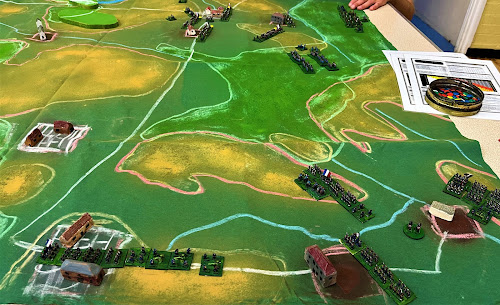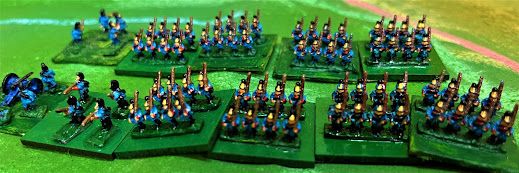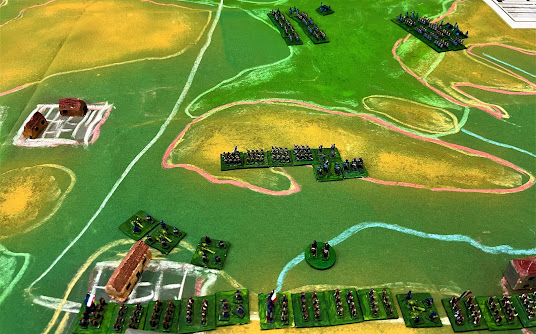So often, my AARs finish by saying something like, "so after a nailbiting climax that could have gone either way, with multiple objectives contested on the final turn until the last throw of the dice, it ended as a classic BBB draw". Not so this week!
Crispin offered us one of the Franco-Prussian War scenarios from the BBB rulebook: Beaumont. This is a fighting withdrawal, one of the more interesting situations to wargame and one that doesn't find its way onto our tables often enough, but a tricky one to pitch the victory conditions just right. At Beaumont, a French corps gets caught and mauled by the advancing Germans as it is about to try to move away from them across the Meuse. The BBB scenario actually makes the situation more interesting by including additional forces further west, where another French corps ended up being forced apart from the others.
Dave and I took the part of Failly (French 5th Corps) and Douay (7th Corps) respectively, while Matt took the Bavarians and German V Korps, leaving John with IV Korps and the Saxons.
The French deploy first. They have one important decision to make immediately: whether to deploy part of 5 Cps forward in Beausejour (forcing IV Kps to start further back) or hold it all further north in and behind Beaumont. We opted for the forward deployment. As it turned out, that may have been an error. The captioned pictures below illustrate why. (Skip past them if you can't wait to read my perceptive, witty and erudite reflections and resulting profound insights arising from the game. If they disappoint you, you can ask for your money back.)

The battlefield, looking east. French 5 Cps top right facing Germans in the woods. French 7 Cps bottom right, most of it out of shot bottom right corner. We need to traverse the whole table and get across the Meuse to join 12 Cps at Mouzon, top left. This is made more difficult by the terrain. Brownish areas are hills; pinkish edges indicate steep slopes. Green chalked areas are woods. Unfortunately, after going to all the trouble of making this custom mat, Crispin forgot to bring his trees.
A better view of my command. Most of it is forced to set up having responded to the Germans' proximity by instinctively deploying to fight them off. First order of business will be to get it back into march columns. Top right can be seen the two brigades of 5 Cps that we pushed forward into Beausejour and onto the hill next to it.
Two brigades of Bavarians start the game in the woods between 5 and 7 Cps. These would swiftly push into the gap between our French formations and make life extremely difficult for 7 Cps.
End of Turn 1. Both Bavarian brigades have reached the edge of the woods, top centre, with another two following them. No such slick efficiency on the French side: my lead column failed to move at all, blocking the road, while all my artillery managed half-moves only. This was rather crucial - I really needed to get something, anything, deployed around La Besace (the town left center) to screen the rest of my troops marching towards Mouzon.

End of Turn 4 or 5, I think, and the battle has moved on. Top centre: 5 Cps has lost its two forward units and been kicked out of Beaumont, overwhelmed by German numbers, while Saxon reinforcements from top right are arriving on its left flank. That solitary unit left centre of pic is not an escaping French division, unfortunately, but the lead Bavarian brigade barring our way. I now have a division in La Besace (centre of pic), but too late to be useful. Three brigades and my artillery have made it through the large wood but still have a long way to go. My other brigade has disappeared, as German V Kps (bottom right) caught the tail of my column and chewed it off.
A closer look at the ominously tight-packed and well-drilled assault columns of V Kps, with batteries of Krupps rumbling up behind them.
And a close-up of their prey, my 7 Cps columns desperately sweating up hill and down dale to escape.
Turn 6 or 7. One of my units is winning the firefight against the lead Bavarian brigade, but that has done its job by forcing my columns to detour so far that it is doubtful whether they can reach the bridges in time. My unit stuck in La Besace (top right) seems doomed to fight a rearguard action that it will not survive.
Game end. Dave got some of his 5 Cps artillery away but none his infantry escaped. This shot shows the only unit of mine to reach the bridge, about to be shot up badly by Prussian needleguns as it crosses. We fell a little short of our victory target: we needed to extract five infantry units and three artillery for a draw, or six and four to win. Dave got enough guns away, but one solitary infantry unit was all we managed between us. Hence we were utterly trounced.
Reflections:
Is the Scenario Balanced? When you lose a game as badly as we did, you can't help wondering whether the scenario is skewed against you. The French have 10 infantry units south of the Meuse, of which five or six have to escape, so they can only afford to lose/leave four or five at most. They are also handicapped by being Passive. Did we have an impossible task?
Well, maybe not. From looking at the report in the BBB group files of our epic campaign in which we fought all 9 battles in a 3-day weekend, I see that although Beaumont was a German victory then too, it was a lot closer - the French actually got enough infantry off the table and were unlucky not to get the guns away too.
In this week's game, a few things all went wrong straight away. In some game situations, a run of bad dice early on can be made up for by good ones later. In a fighting withdrawal like Beaumont, it can harder for the withdrawing side to recover from initial setbacks - once you're caught, you really have to stop and fight; if someone gets in your way to start with, getting through or past them becomes so much more difficult.
In our case, (a) we committed troops forward instead of sitting back to exploit the longer range of our massed chassepots; (b) all the crucial units at the head of my column failed to get enough movement to cover the rest; and (c) Matt's Bavarians then got the good rolls they needed to get in my way. From there it just cascaded bad to worse. I think it fair to say that, on my side of the pitch at least, it was compounded by Matt rolling plenty of deadly high firing dice, while mine were consistently ordinary.
Regardless, the boys are keen to roll this one out again in the near future, so maybe we'll find that it can go very differently with a few different dice (and better French plans).
Does Scenario Balance Matter? Even if the scenario is skewed and we were doomed from the start - how much does it matter? We all had fun and kept smiling (even if the smiles were wry ones as Matt rolled another 11 to kill off my chasseurs, or as one of my columns yet again refused to demonstrate any sense of urgency and stopped for coffee and croissants in the woods). We're not tournament gamers, so it's about the journey, not the destination.
All true, but still, the journey is more exciting when it's not so obvious where you're going to end up. I enjoyed the game but I'm sure I'd have enjoyed it more if we'd still had a chance of getting enough troops away towards the end. That makes it a qualified 'yes', in that a balanced scenario where both sides have a decent chance of winning isn't essential but does add to the game. (Though I note again - I'm not saying Beaumont definitely isn't balanced.)
Possible tweaks. Historically, the French ended up divided on both sides of the Meuse and headed downriver to Sedan. Perhaps rather than just having to try to cross the Meuse, 7 Cps should be allowed an alternate (nearer, historical) escape route, say anywhere within 6"-12" of the NW corner of the board. Units getting off there might count half as much as if they cross the Meuse. It's always good to have more than one way of winning. Another simple tweak would be just to remove the French 'Passive' rating.















